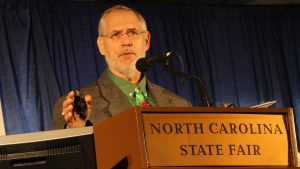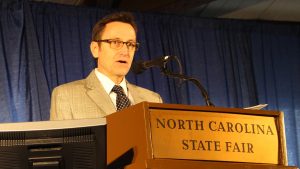Economists Share 2017 Outlook at Ag Development Forum

2017 will likely bring continued downward pressure on North Carolina agricultural commodity prices, but the state’s economy as a whole may see slightly accelerated growth.
That’s the message two NC State University economists brought to participants in the recent Ag Development Forum in Raleigh. The annual forum, hosted by the N.C. Department of Agriculture and Consumer Services, took place Feb. 2 at the North Carolina State Fairgrounds.
Dr. Mike Walden discussed some of the key economic goals of President Donald Trump’s new administration, while Dr. Blake Brown focused on the outlook for North Carolina’s farmers.
Walden and Brown are in the College of Agriculture and Life Sciences’ Department of Agricultural and Resource Economics. Walden is William Neal Reynolds Distinguished Professor, and Brown is Hugh C. Kiger Professor.

Walden said that, since the last recession, the economy has grown by an average of about 2 percent annually, but Trump has stated that he’d like to double that growth rate to 4 percent. To do that, the president has proposed reducing tax rates, spending more on infrastructure such as highways and airports, reducing regulations and increasing energy production. He’s also talked about expanding military capability, which could mean more military spending, Walden said.
Still, Walden foresees only a slight uptick in the national economic growth – in the 2.2 to 2.3 percent range. “I hope I’m wrong, but I think it’s going to be a difficult job to get the economy growing at a 4 percent rate,” he said.
When it comes to North Carolina, Walden predicted that jobs will continue to grow faster at the upper and lower ends of the income spectrum than in the middle. “That’s contributing to this sense of income inequality that you hear about,” he said, and it means fewer options for lower-paid workers who want to move up the income ladder.
Another major economic divide in North Carolina that Walden expects to persist is between regions: The big metropolitan areas have seen the greatest economic growth rates, and their populations have been growing fastest, Walden said. “North Carolina is moving toward being a more densely populated state, particularly in urban areas,” he said.
While Walden forecast economic growth in the overall economy, Brown’s outlook for the agricultural audience was, as Brown said, “not the rosiest.”

In 2013, net farm income in the United States was at a record high, while North Carolina reached a peak in 2014. That led to agricultural expansion, and now, with greater crop inventories on hand, prices for many commodities have slumped, he explained.
Still because feed prices are lower, the state’s livestock producers could fare better than they did a few years ago, when high feed prices raised their production costs, Brown said.
Cotton is also an important commodity for North Carolina, Brown said, but lower oil prices and higher-tech fibers have made polyester a stronger competitor. “What we need in cotton is another technological leap like we had in the 1980s (with) wrinkle-free cotton,” he said. “Until that happens, I’m afraid we are going to be dealing with a difficult situation.”
With another crop, soybeans, the outlook is “fairly bright” for North Carolina, Brown said. Poor weather and infrastructure problems are hurting our major soybean competitor, Brazil. At the same time, demand for soybeans is high, in part for feeding expanding livestock herds.
Demand for sweet potatoes has also risen in recent years, but Brown cautioned that production may be getting ahead of demand.
“Yes, demand continues to grow for sweet potatoes, and I don’t see an end to that, but we are really, really good at producing, and we get ahead of demand when we are not careful. We may have done that a little bit in 2016,” he said. “We’ll have to figure out how to moderate that or continue to grow that consumption.”
In summing up his outlook for North Carolina, Brown said that “farmers bring some perspective on this: You have to be in it for the long haul. We have been through times like this before,” he said, “and we are going to get through them again.”
This post was originally published in College of Agriculture and Life Sciences News.


